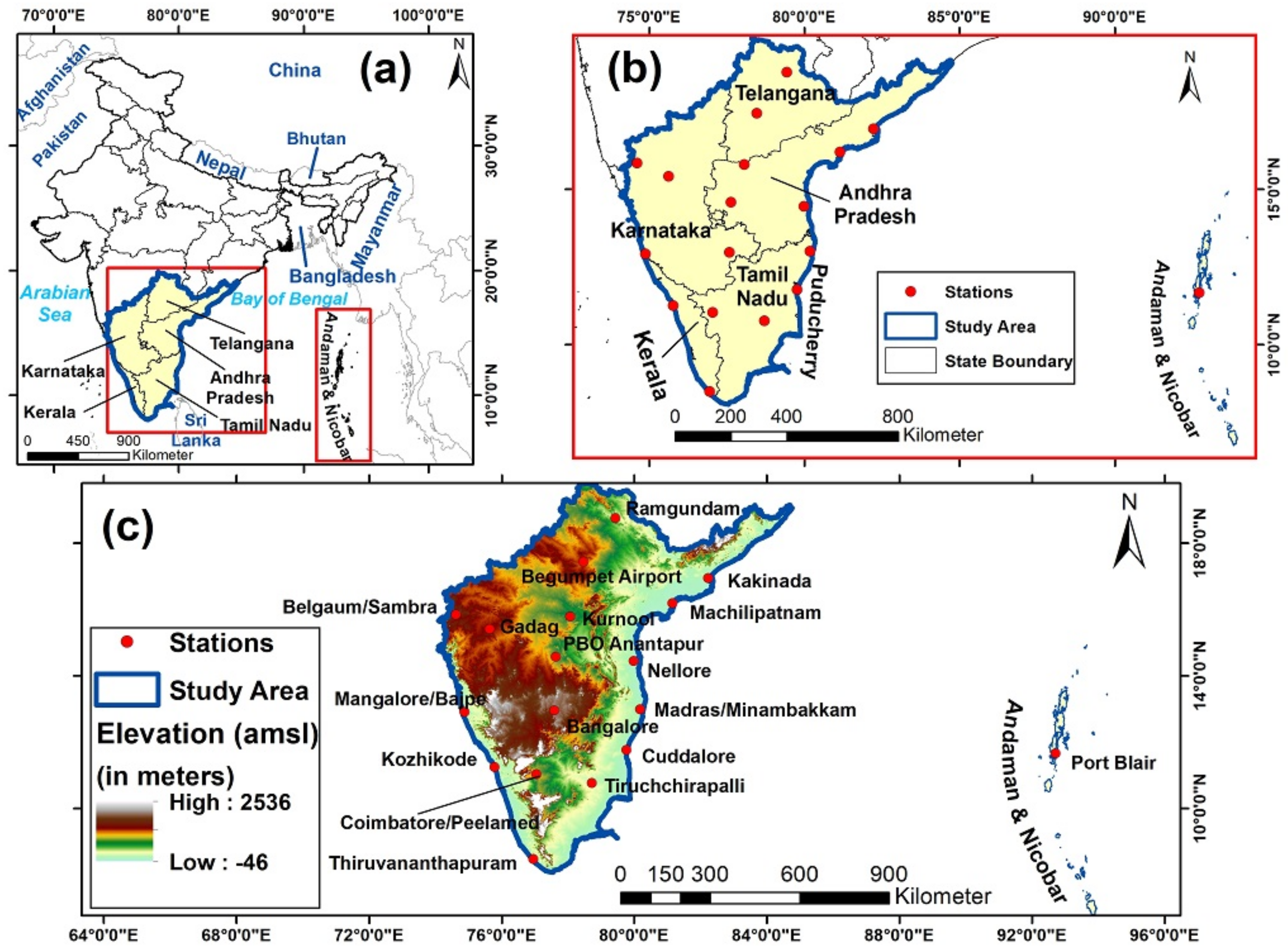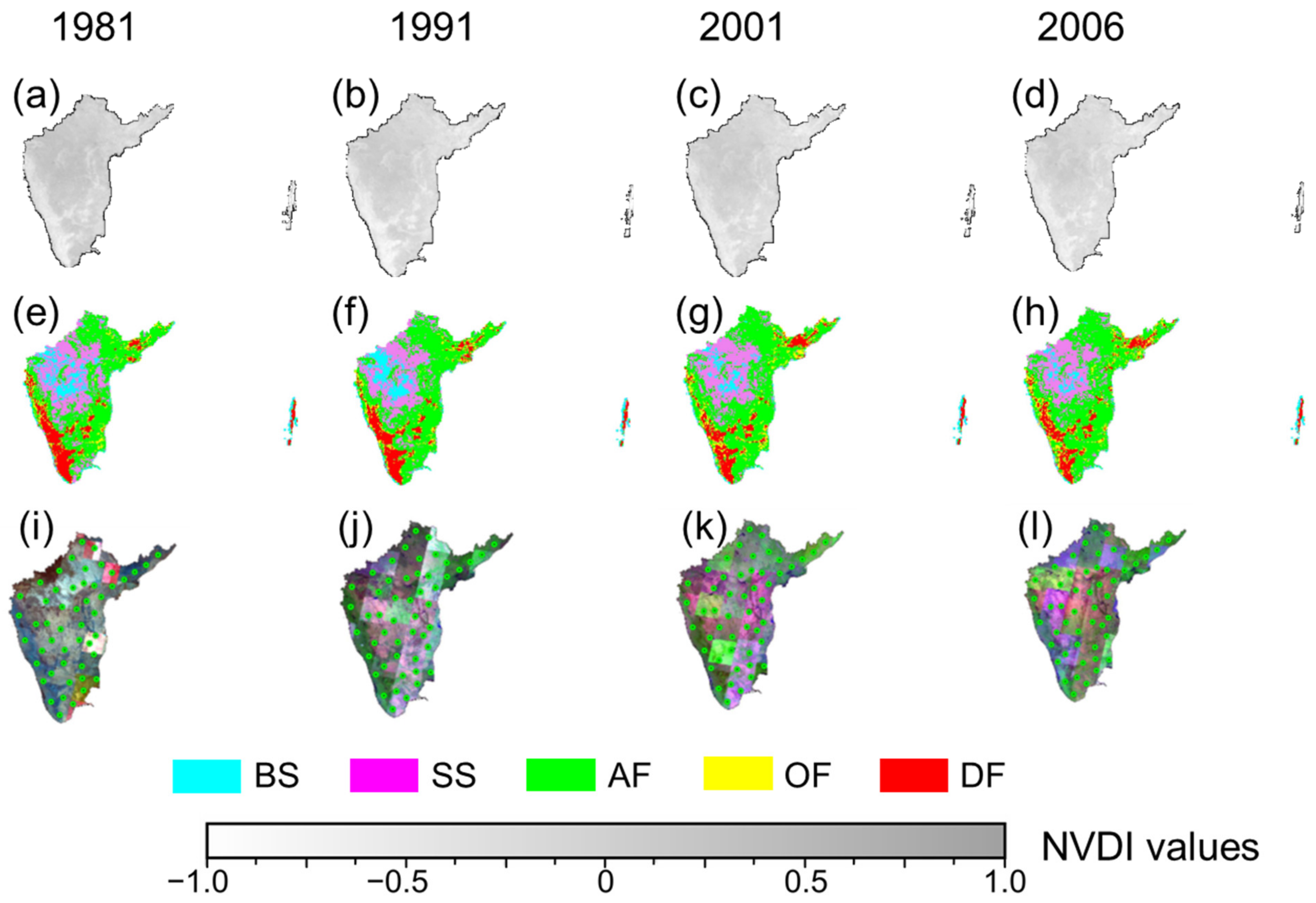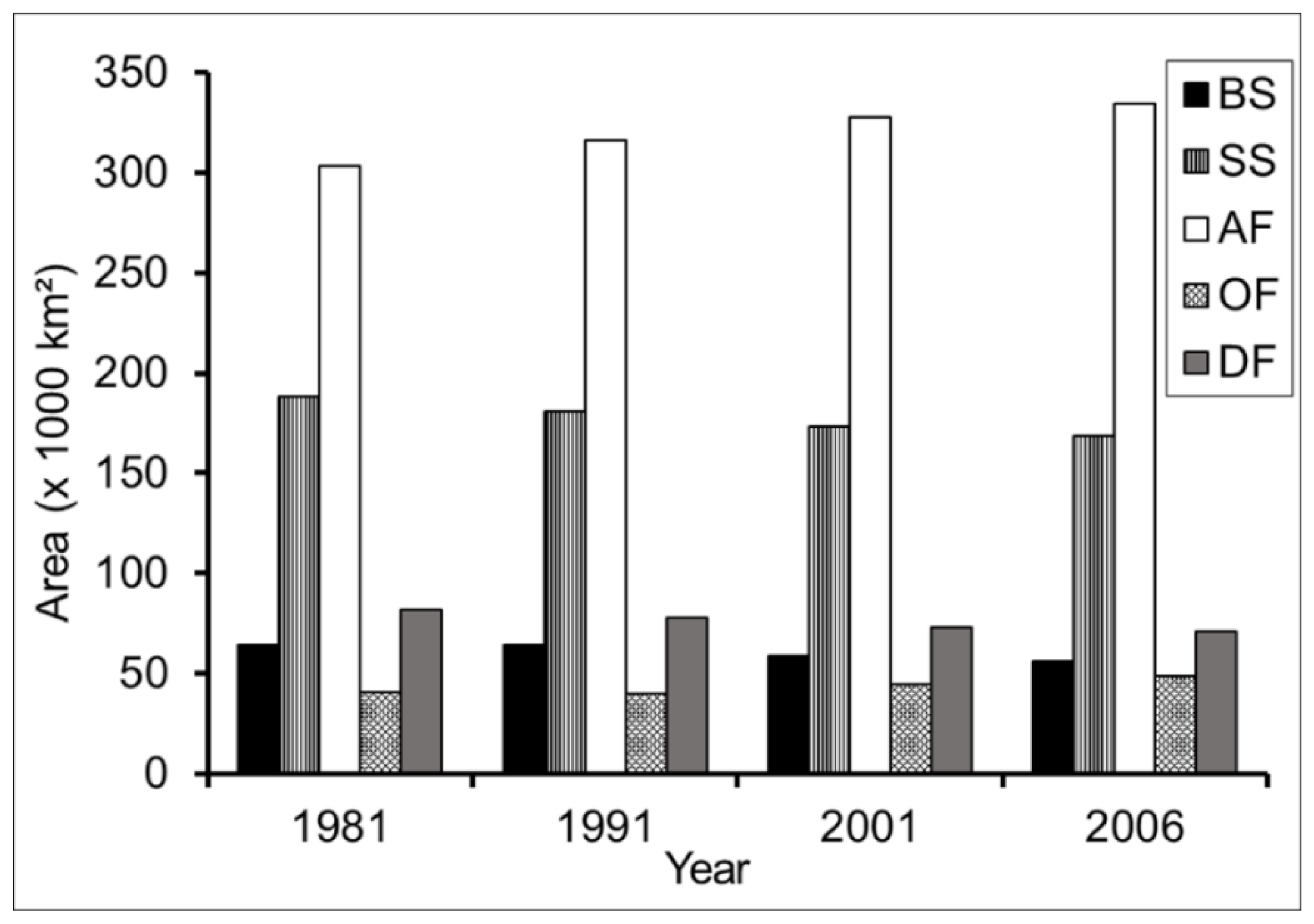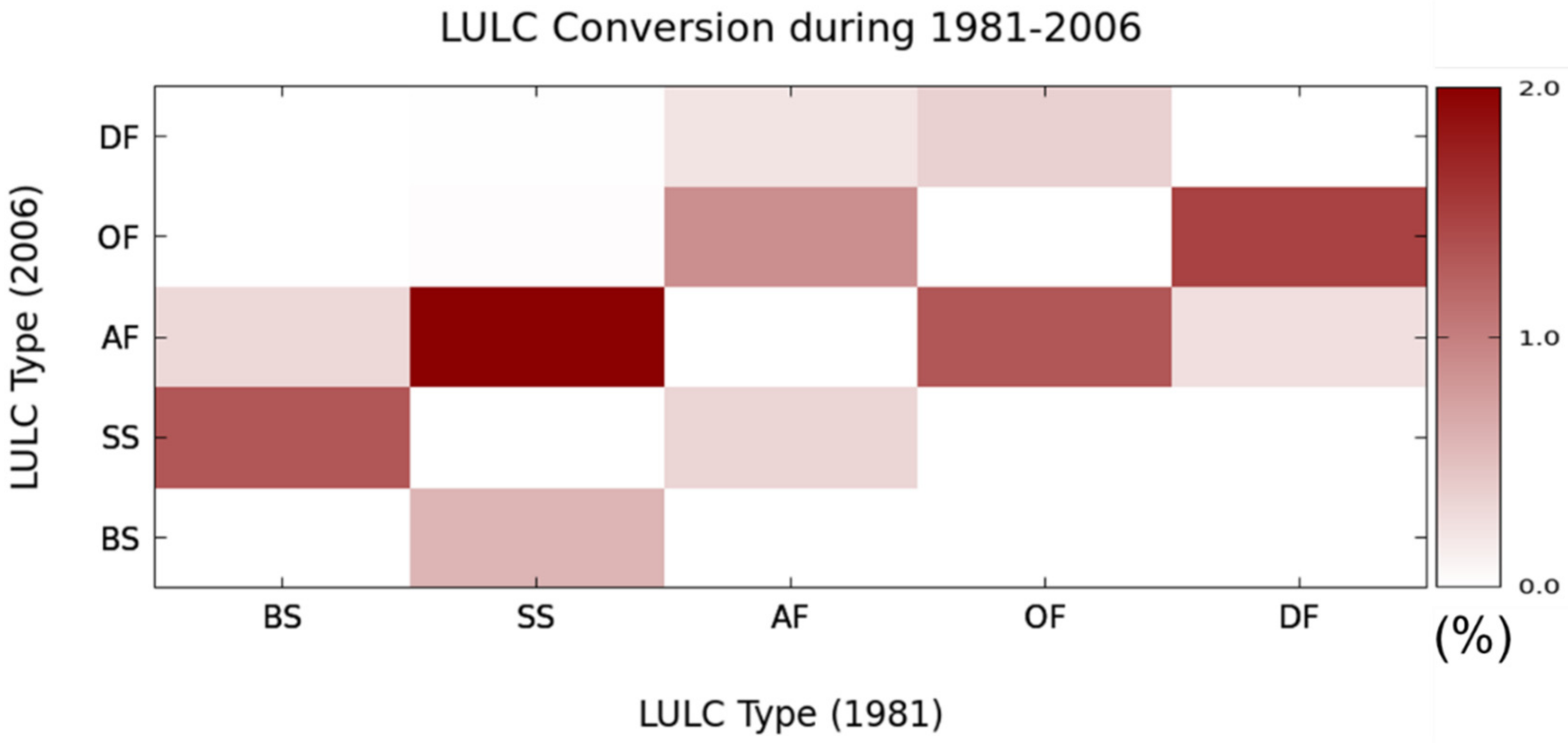Application of “Observation Minus Reanalysis” Method towards LULC Change Impact over Southern India
Abstract
1. Introduction
2. Data and Methods
3. Results and Discussion
3.1. Spatial Distributions of the LULC Classification and the Accuracy Assessment
3.2. LULC Change Analysis
3.3. OMR Analysis
4. Conclusions
Author Contributions
Funding
Data Availability Statement
Acknowledgments
Conflicts of Interest
References
- Intergovernmental Panel on Climate Change (IPCC). The Physical Science Basis. In Fourth Assessment Report of the Intergovernmental Panel on Climate Change; Solomon, S., Qin, D., Manning, M., Chen, Z., Marquis, M., Averyt, K.B., Tignor, M., Miller, H.L., Eds.; Cambridge University Press: Cambridge, UK, 2007. [Google Scholar]
- Intergovernmental Panel on Climate Change (IPCC). Climate Change 2013: The Physical Science Basis. In Contribution of Working Group I to the Fifth Assessment Report of the Intergovernmental Panel on Climate Change; Stocker, T.F., Qin, D., Plattner, G.-K., Tignor, M., Allen, S.K., Boschung, J., Nauels, A., Xia, Y., Bex, V., Midgley, P.M., Eds.; Cambridge University Press: Cambridge, UK; New York, NY, USA, 2013; pp. 5–14. [Google Scholar]
- Sahu, N.; Saini, A.; Behera, S.K.; Sayama, T.; Sahu, L.; Nguyen, V.-T.-V.; Takara, K. Why apple orchards are shifting to the higher altitudes of the Himalayas? PLoS ONE 2020, 15, e0235041. [Google Scholar] [CrossRef]
- Viterbo, P. The role of the land surface in the climate system. In Meteorological Training Course Lecture Series, European Centre for Medium Range Weather Forecasting (ECMWF); ECMWF: Reading, UK, 2002. [Google Scholar]
- Teuling, A.J.; Seneviratne, S.I.; Stöckli, R.; Reichstein, M.; Moors, E.; Ciais, P.; Luyssaert, S.; van den Hur Ammann, B.; Bernhofer, C. Contrasting response of European forest and grassland energy exchange to heatwaves. Nat. Geosci. 2010, 3, 722–727. [Google Scholar] [CrossRef]
- Jain, S.; Panda, L.; Kant, S. Possible Socio-scientific Issues of Land-use and Land-cover Change Impact and Associated Tools of Study with a Special Reference to Delhi-Mumbai Industrial Corridor Region. Int. J. Earth Atmos. Sci. 2014, 1, 58–70. [Google Scholar]
- Li, Y.; Zhao, M.; Motesharrei, S.; Mu, Q.; Kalnay, E.; Li, S. Local cooling and warming effects of forest based on satellite data. Nat. Commun. 2015, 6, 6603. [Google Scholar] [CrossRef]
- Maity, S.; Satyanarayana, A.N.V.; Mandal, M.; Nayak, S. Performance evaluation of land surface models and cumulus convection schemes in the simulation of Indian summer monsoon using a regional climate model. Atmos. Res. 2017, 197, 21–41. [Google Scholar] [CrossRef]
- Mushore, T.D.; Odindi, J.; Dube, T.; Mutanga, O. Prediction of future urban surface temperatures using medium resolution satellite data in Harare metropolitan city, Zimbabwe. Build. Environ. 2017, 122, 397–410. [Google Scholar] [CrossRef]
- Roy, S.; Pandit, S.; Eva, E.A.; Bagmar, M.S.H.; Papia, M.; Banik, L.; Razi, M.A. Examining the nexus between land surface temperature and urban growth in Chattogram Metropolitan Area of Bangladesh using long term Landsat series data. Urban Clim. 2020, 32, 100593. [Google Scholar] [CrossRef]
- Tan, J.; Yu, D.; Li, Q.; Tan, X.; Zhou, W. Spatial relationship between land-use/land-cover change and land surface temperature in the Dongting Lake area, China. Sci. Rep. 2020, 10, 1–9. [Google Scholar] [CrossRef]
- Mall, R.K.; Chaturvedi, M.; Singh, N.; Bhatla, R.; Singh, R.S.; Gupta, A.; Niyogi, D. Evidence of asymmetric change in diurnal temperature range in recent decades over different agro-climatic zones of India. Int. J. Climatol. 2021, 41, 2597–2610. [Google Scholar] [CrossRef]
- Nayak, S.; Mandal, M.; Maity, S. Assessing the impact of Land-use and Land-cover changes on the climate over India using a Regional Climate Model (RegCM4). Clim. Res. 2021, 85, 1–20. [Google Scholar] [CrossRef]
- Bryant, N.A.; Johnson, L.F.; Brazel, A.J.; Balling, R.C.; Hutchinson, C.F.; Beck, L.R. Measuring the effect of overgrazing in the Sonoran Desert. Clim. Chang. 1990, 17, 243–264. [Google Scholar] [CrossRef]
- Gallo, K.P.; Easterling, D.R.; Peterson, T.C. The influence of land use/land cover on Climatological values of the diurnal temperature ranges. J. Clim. 1996, 9, 2941–2944. [Google Scholar] [CrossRef]
- Balling, R.C.; Vose, R.S.; Weber, G.R. Analysis of long-term European temperature records: 1751–1995. Clim. Res. 1998, 10, 193–200. [Google Scholar] [CrossRef]
- Kalnay, E.; Cai, M. Impact of urbanization and land-use change on climate. Nature 2003, 423, 528–531. [Google Scholar] [CrossRef] [PubMed]
- Zhou, L.M.; Dickinson, R.E.; Tian, Y.H. Evidence for a significant urbanization effect on climate in China. In Proceedings of the National Academy of Science, New York, NY, USA, 29 June 2004; Volume 101, pp. 9540–9544. [Google Scholar]
- Frauenfeld, O.W.; Zhang, T.; Serreze, M.C. Climate change and variability using European Centre for Medium-Range Weather Forecasts reanalysis (ERA-40) temperatures on the Tibetan Plateau. J. Geophys. Res. 2005, 110, D02101. [Google Scholar] [CrossRef]
- Christy, J.R.; Norris, W.B.; Redmond, K.; Gallo, K.P. Methodology and results of calculating central California surface temperature trends: Evidence of human-induced climate change? J. Clim. 2006, 19, 548–563. [Google Scholar] [CrossRef]
- Sahu, N.; Singh, R.B.; Kumar, P.; Da Silva, R.V.; Behera, S.K. La Niña Impacts on Austral Summer Extremely High-Streamflow Events of the Paranaíba River in Brazil. Adv. Meteorol. 2013, 2013, 461693. [Google Scholar] [CrossRef]
- Mukherjee, F.; Singh, D. Assessing Land Use–Land Cover Change and Its Impact on Land Surface Temperature Using LANDSAT Data: A Comparison of Two Urban Areas in India. Earth Syst. Environ. 2020, 4, 385–407. [Google Scholar] [CrossRef]
- Kayet, N.; Pathak, K.; Chakrabarty, A.; Sahoo, S. Spatial impact of land use/land cover change on surface temperature distribution in Saranda Forest, Jharkhand. Model. Earth Syst. Environ. 2016, 2, 127. [Google Scholar] [CrossRef]
- Gogoi, P.P.; Vinoj, V.; Swain, D.; Roberts, G.; Dash, J.; Tripathy, S. Land use and land cover change effect on surface temperature over Eastern India. Sci. Rep. 2019, 9, 1–10. [Google Scholar]
- Halder, S.; Saha, S.K.; Dirmeyer, P.A.; Chase, T.N.; Goswami, B.N. Investigating the impact of land-use land-cover change on Indian summer monsoon daily rainfall and temperature during 1951−2005 using a regional climate model. Hydrol. Earth Syst. Sci. 2016, 20, 1765–1784. [Google Scholar] [CrossRef]
- Nayak, S.; Mandal, M. Impact of land use and land cover changes on temperature trends over India. Land Use Policy 2019, 89, 104238. [Google Scholar] [CrossRef]
- Lodh, A. Simulating the impact of extended desertification on Indian hydro climate using ICTP-RegCM4. 4.5. 10 model. J. Hydrol. 2021, 598, 126405. [Google Scholar] [CrossRef]
- Fall, S.; Watts, A.; Nielsen-Gammon, J.; Jones, E.; Niyogi, D.; Christy, J.R.; McNider, R.; Pielke, R.A., Sr. Analysis of the impacts of station exposure on the U.S. Historical Climatology Network temperatures and temperature trends. J. Geophys. Res. 2011, 116, D14120. [Google Scholar] [CrossRef]
- Jin, X.; Jiang, P.; Du, H.; Chen, D.; Li, M. Response of local temperature variation to land cover and land use intensity changes in China over the last 30 years. Clim. Chang. 2021, 164, 34. [Google Scholar] [CrossRef]
- Lim, Y.K.; Cai, M.; Kalnay, E.; Zhou, L. Impact of Vegetation Types on Surface Temperature Change. J. Appl. Meteorol. Climatol. 2008, 47, 411–424. [Google Scholar] [CrossRef]
- Nayak, S.; Behera, M.D. Land use/land cover classification and mapping of Pilibhit District Uttar Pradesh India. Indian Geogr. J. 2008, 83, 15–24. [Google Scholar]
- Vinayak, B.; Lee, H.S.; Gedem, S. Prediction of Land Use and Land Cover Changes in Mumbai City, India, Using Remote Sensing Data and a Multilayer Perceptron Neural Network-Based Markov Chain Model. Sustainability 2021, 13, 471. [Google Scholar] [CrossRef]
- Babykalpana, Y. Landuse Landcover change detection using remotely sensed data for Coimbatore district, India. Int. J. Sci. Eng. Res. 2012, 3, 1–8. [Google Scholar]
- Rawat, J.S.; Biswas, V.; Kumar, M. Changes in land use/cover using geospatial techniques: A case study of Ramnagar town area, district Nainital, Uttarakhand, India. Egypt. J. Remote Sens. Space Sci. 2013, 16, 111–117. [Google Scholar] [CrossRef]
- Niyogi, D.; Pyle, P.; Lei, M.; Arya, S.P.; Kishtawal, C.M.; Shepherd, M.; Chen, F.; Wolfe, B. Urban modification of thunderstorms: An observational storm climatology and model case study for the Indianapolis urban region. J. Appl. Meteorol. Climatol. 2011, 50, 1129–1144. [Google Scholar] [CrossRef]
- Mohan, M.; Kandya, A. Impact of urbanization and land-use/land-cover change on diurnal temperature range: A case study of tropical urban airshed of India using remote sensing data. Sci. Total Environ. 2015, 506, 453–465. [Google Scholar] [CrossRef]
- Kedia, S.; Bhakare, S.P.; Dwivedi, A.K.; Islam, S.; Kaginalkar, A. Estimates of change in surface meteorology and urban heat island over northwest India: Impact of urbanization. Urban Clim. 2021, 36, 100782. [Google Scholar] [CrossRef]
- Nayak, S.; Mandal, M. Impact of land use and land cover change on temperature trends over Western India. Curr. Sci. 2012, 102, 1166–1173. [Google Scholar]
- Nayak, S. Land use and land cover change and their impact on temperature over central India. Lett. Spat. Resour. Sci. 2021, 14, 1–12. [Google Scholar] [CrossRef]
- Singh, P.; Kikon, N.; Verma, P. Impact of land use change and urbanization on urban heat island in Lucknow city, Central India. A remote sensing based estimate. Sustain. Cities Soc. 2017, 32, 100–114. [Google Scholar] [CrossRef]
- Nayak, S.; Maity, S.; Singh, K.S.; Nayak, H.P.; Dutta, S. Influence of the Changes in Land-Use and Land Cover on Temperature over Northern and North-Eastern India. Land 2021, 10, 52. [Google Scholar] [CrossRef]
- Prijith, S.S.; Srinivasarao, K.; Lima, C.B.; Gharai, B.; Rao, P.V.N.; SeshaSai, M.V.R.; Ramana, M.V. Effects of land use/land cover alterations on regional meteorology over Northwest India. Sci. Total Environ. 2021, 765, 142678. [Google Scholar] [CrossRef]
- Nayak, S.; Mandal, M. Examining the impact of regional land use and land cover changes on temperature: The case of Eastern India. Spat. Inf. Res. 2019, 27, 601–611. [Google Scholar] [CrossRef]
- Oliver, J.E.; Wilson, L. Climate classification. In The Encyclopedia of Climatology; Oliver, J.E., Fairbridge, R.W., Eds.; Van Nostrand Reinhold Company: New York, NY, USA, 1987; pp. 221–236. [Google Scholar]
- Saini, A.; Sahu, N.; Kumar, P.; Nayak, S.; Duan, W. Advanced Rainfall Trend Analysis of 117 Years over West Coast Plain and Hill Agro-Climatic Region of India. Atmosphere 2020, 11, 1225. [Google Scholar] [CrossRef]
- Rogan, J.; Chen, D. Remote sensing technology for mapping and monitoring land-cover and land-use change. Prog. Plan. 2004, 61, 301–325. [Google Scholar] [CrossRef]
- Pricope, G.N.; Mapes, K.L.; Woodward, K.D. Remote Sensing of Human–Environment Interactions in Global Change Research: A Review of Advances, Challenges and Future Directions. Remote Sens. 2019, 11, 2783. [Google Scholar] [CrossRef]
- Tucker, C.J.; Pinzon, J.E.; Brown, M.E. Global inventory modeling and mapping studies, NA94apr15b.n11-VIg, 2.0. In Global Land Cover Facility; University of Maryland: College Park, MD, USA, 2004. [Google Scholar]
- Tucker, C.J.; Pinzon, J.E.; Brown, M.E.; Slayback, D.A.; Pak, E.W.; Mahoney, R.; El Saleous, N. An extended AVHRR 8-km NDVI data set compatible with MODIS and SPOT vegetation NDVI data. Int. J. Remote Sens. 2005, 26, 4485–4559. [Google Scholar] [CrossRef]
- Chavula, G.; Brezonik, P.; Bauer, M. Land use and land cover change (LULC) in the Lake Malawi Drainage Basin, 1982–2005. Int. J. Geosci. 2011, 2, 172. [Google Scholar] [CrossRef][Green Version]
- John, R.; Chen, J.; Lu, N.; Wilske, B. Land cover/land use change in semi-arid Inner Mongolia: 1992–2004. Environ. Res. Lett. 2009, 4, 045010. [Google Scholar] [CrossRef]
- DeFries, R.S.; Townshend, J.R.G. NDVI-derived land cover classifications at a global scale. Int. J. Remote Sens. 1994, 15, 3567–3586. [Google Scholar] [CrossRef]
- Hansen, M.C.; DeFries, R.S.; Townshend, J.R.; Sohlberg, R. Global land cover classification at 1 km spatial resolution using a classification tree approach. Int. J. Remote Sens. 2000, 21, 1331–1364. [Google Scholar] [CrossRef]
- Nayak, S.; Mandal, M.; Maity, S. RegCM4 simulation with AVHRR land use data towards temperature and precipitation climatology over Indian region. Atmos. Res. 2018, 214, 163–173. [Google Scholar] [CrossRef]
- Nayak, S.; Mandal, M.; Maity, S. Customization of regional climate model (RegCM4) over Indian region. Theor. Appl. Climatol. 2017, 127, 153–168. [Google Scholar] [CrossRef]
- Maity, S.; Mandal, M.; Nayak, S.; Bhatla, R. Performance of cumulus parameterization schemes in the simulation of Indian Summer Monsoon using RegCM4. Atmósfera 2017, 30, 287–309. [Google Scholar] [CrossRef][Green Version]
- Nayak, S.; Mandal, M.; Maity, S. Performance evaluation of RegCM4 in simulating temperature and precipitation climatology over India. Theor. Appl. Climatol. 2019, 137, 1059–1075. [Google Scholar] [CrossRef]
- Creutzig, F.; d’Amour, C.B.; Weddige, U.; Fuss, S.; Beringer, T.; Gläser, A.; Kalkuhl, M.; Steckel, J.C.; Radebach, A.; Edenhofer, O. Assessing human and environmental pressures of global land-use change 2000–2010. Glob. Sustain. 2019, 2, e1. [Google Scholar] [CrossRef]
- Jha, C.S.; Dutt, C.B.S.; Bawa, K.S. Deforestation and land use changes in Western Ghats, India. Curr. Sci. 2020, 79, 231–238. [Google Scholar]
- Baldocchi, D.; Liukang, X. What limits evaporation from Mediterranean oak woodlands-the supply of moisture in the soil, physiological control by plants or the demand by the atmosphere? Adv. Water Resour. 2007, 30, 2113–2122. [Google Scholar] [CrossRef]
- Wang, X.; Zhang, B.; Xu, X.; Tian, J.; He, C. Regional water-energy cycle response to land use/cover change in the agro-pastoral ecotone, Northwest China. J. Hydrol. 2020, 580, 124246. [Google Scholar] [CrossRef]
- Li, J.; Tam, C.Y.; Tai, A.P.; Lau, N.C. Vegetation-heatwave correlations and contrasting energy exchange responses of different vegetation types to summer heatwaves in the Northern Hemisphere during the 1982–2011 period. Agric. For. Meteorol. 2021, 296, 108208. [Google Scholar] [CrossRef]
- Tran, D.X.; Pla, F.; Latorre-Carmona, P.; Myint, S.W.; Caetano, M.; Kieu, H.V. Characterizing the relationship between land use land cover change and land surface temperature. ISPRS J. Photogramm. Remote Sens. 2017, 124, 119–132. [Google Scholar] [CrossRef]






| Station | Longitude (°E) | Latitude (°N) | Height (m) above Sea Level | Area Type |
|---|---|---|---|---|
| Bangalore | 77.583 | 12.967 | 910 | Urban |
| Begumpet Airport | 78.467 | 17.450 | 527 | Urban |
| Belgaum/Sambra | 74.617 | 15.850 | 771 | Non-urban |
| Coimbatore/Peelamed | 77.050 | 11.033 | 389 | Urban |
| Cuddalore | 79.767 | 11.767 | 15 | Urban |
| Gadag | 75.633 | 15.417 | 661 | Urban |
| Kakinada | 82.233 | 16.950 | 9 | Urban |
| Kozhikode | 75.783 | 11.250 | 15 | Urban |
| Kurnool | 78.067 | 15.800 | 283 | Urban |
| Machilipatnam | 81.150 | 16.200 | 8 | Urban |
| Madras/Minambakkam | 80.183 | 13.000 | 18 | Urban |
| Mangalore/Bajpe | 74.883 | 12.917 | 92 | Non-urban |
| Nellore | 79.983 | 14.450 | 23 | Urban |
| PBO Anantapur | 77.633 | 14.583 | 372 | Non-urban |
| Port Blair | 92.717 | 11.667 | 10 | Non-urban |
| Ramgundam | 79.433 | 18.767 | 170 | Non-urban |
| Thiruvananthapuram | 76.950 | 8.483 | 13 | Urban |
| Tiruchchirapalli | 78.717 | 10.767 | 84 | Urban |
| LULC Type | 1981 | 1991 | 2001 | 2006 | ||||
|---|---|---|---|---|---|---|---|---|
| Producer’s Accuracy (%) | User’s Accuracy (%) | Producer’s Accuracy (%) | User’s Accuracy (%) | Producer’s Accuracy (%) | User’s Accuracy (%) | Producer’s Accuracy (%) | User’s Accuracy (%) | |
| BS | 75.00 | 100.00 | 100.00 | 66.67 | 100.00 | 100.00 | 50.00 | 100.00 |
| SS | 85.71 | 80.00 | 73.33 | 84.62 | 84.62 | 100.00 | 76.92 | 90.91 |
| AF | 95.00 | 90.48 | 90.91 | 86.96 | 96.30 | 92.86 | 100.00 | 89.29 |
| OF | 50.00 | 100.00 | 50.00 | 100.00 | 100.00 | 50.00 | 66.67 | 100.00 |
| DF | 100.00 | 88.89 | 100.00 | 90.00 | 87.50 | 87.50 | 100.00 | 87.50 |
| Overall accuracy | 88.00% | 86.00% | 92.00% | 90.00% | ||||
| LULC Type | 1981–1990 | 1991–2000 | 2001–2006 | 1981–2006 |
|---|---|---|---|---|
| BS | −0.06 | −0.80 | −0.387 | −1.246 |
| SS | −1.10 | −1.04 | −0.782 | −2.925 |
| AF | 1.91 | 1.76 | 0.962 | 4.624 |
| OF | −0.17 | 0.77 | 0.594 | 1.198 |
| DF | −0.58 | −0.69 | −0.387 | −1.651 |
Publisher’s Note: MDPI stays neutral with regard to jurisdictional claims in published maps and institutional affiliations. |
© 2022 by the authors. Licensee MDPI, Basel, Switzerland. This article is an open access article distributed under the terms and conditions of the Creative Commons Attribution (CC BY) license (https://creativecommons.org/licenses/by/4.0/).
Share and Cite
Nayak, S.; Maity, S.; Sahu, N.; Saini, A.; Singh, K.S.; Nayak, H.P.; Dutta, S. Application of “Observation Minus Reanalysis” Method towards LULC Change Impact over Southern India. ISPRS Int. J. Geo-Inf. 2022, 11, 94. https://doi.org/10.3390/ijgi11020094
Nayak S, Maity S, Sahu N, Saini A, Singh KS, Nayak HP, Dutta S. Application of “Observation Minus Reanalysis” Method towards LULC Change Impact over Southern India. ISPRS International Journal of Geo-Information. 2022; 11(2):94. https://doi.org/10.3390/ijgi11020094
Chicago/Turabian StyleNayak, Sridhara, Suman Maity, Netrananda Sahu, Atul Saini, Kuvar Satya Singh, Hara Prasad Nayak, and Soma Dutta. 2022. "Application of “Observation Minus Reanalysis” Method towards LULC Change Impact over Southern India" ISPRS International Journal of Geo-Information 11, no. 2: 94. https://doi.org/10.3390/ijgi11020094
APA StyleNayak, S., Maity, S., Sahu, N., Saini, A., Singh, K. S., Nayak, H. P., & Dutta, S. (2022). Application of “Observation Minus Reanalysis” Method towards LULC Change Impact over Southern India. ISPRS International Journal of Geo-Information, 11(2), 94. https://doi.org/10.3390/ijgi11020094











